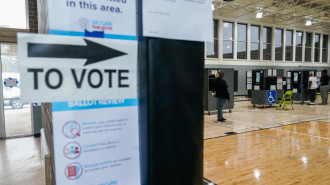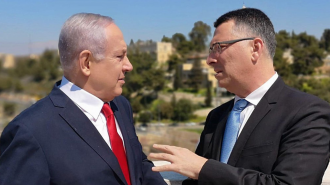Why is Gaza's Shujaiya neighbourhood considered a 'deathtrap' for Israeli forces?
The deaths of ten Israeli soldiers in Gaza on Tuesday made it the single deadliest day for the Israeli military since the launch of its ground assault on 27 October.
Nine of the fatalities, including two senior officers, were killed in Gaza's Shujaiya neighbourhood in a series of ambushes by fighters from Hamas's Al-Qassam Brigade, giving it a reputation as a "deathtrap" for Israeli forces.
What happened on Tuesday?
Palestinian fighters from the Al-Qassam Brigades on Tuesday coordinated a series of ambushes of Israeli soldiers who were carrying out "clearing operations" in Shujaiya, one of Gaza's oldest neighbourhoods.
The first attack targeted a unit from Israel's Golani Brigade and a search and rescue team was dispatched to prevent their abduction. This was also ambushed by Hamas fighters.
The series of operations left nine Israeli troops dead, including two members of the search and rescue unit. Air support was called in to rescue the remainder of the Israeli unit.
It is the highest death toll for Israeli forces in a single day since the launch of the so-called "Operation Iron Swords" on Gaza, following Hamas's 7 October deadly attacks in southern Israel.
Shujaiya was also where Israel incurred its highest death toll during its 2014 "Operation Protective Edge" when 16 Israeli troops died.
Shujaiya: 'The Guard'
Shujaiya is one of Gaza City's largest and most densely-populated neighbourhoods, with a population of 110,000, before Israel's current assault, spanning six square kilometres.
It is situated east of the city and close to the border of the besieged enclave, lying just 700 metres from the Israeli kibbutz of Nahal Oz, in the so-called "Gaza Envelope".
Nahal Oz was one of the kibbutzes attacked by Palestinian fighters on 7 October. According to Channel 12's security correspondent Nir Dvori, Israel is intent on clearing the Shujaiya neighbourhood to create a buffer zone for Nahal Oz.
The neighbourhood is the site of Tell Al-Muntar, a hill which has given the area military significance for centuries. It has historically been considered the gate to Gaza, due to its commanding views and strategic access to the whole of Gaza City.
🧵Latest on Israel's war on Gaza
— The New Arab (@The_NewArab) December 15, 2023
👉Israeli strike on UNRWA school kills 12 as Gaza invasion continues
🔴Live coverage: https://t.co/3zR6C1YrsS pic.twitter.com/OmAGg1h1lZ
Gazan journalist Amjad Yaghi wrote in an article for Al-Araby Al-Jadeed, The New Arab's Arabic-language sister edition, that Shujaiya's nickname is "The Guard", due to it occupying a protective position to the east of Gaza City.
Palestinian journalist Ramzy Baroud describes the Shujaiya Brigades as "mostly comprised of Nukhba forces, the elite units of Al-Qassam".
Legacy of resistance
Historical sources suggest that the name Shujaiya can be attributed to Shuja Al-Din Othman Al-Kurdi, a famous warrior who died in a battle between the Ayyubids and Crusaders in 1239 AD.
The southern part of Shujaiya is called 'Turkman' in honour of the Turkman tribes that joined Saladin during his campaign to liberate Palestine from the Crusader army and its allies in the 1100s.
Ahmad al-Kurdi, 36, a Shujaiya resident, told Alaraby Al-Jadeed that Shujaiya's residents have been repeatedly targeted, and often killed, by Israeli forces due to its proximity with the eastern border of the Gaza Strip.
Possibly the most well-known was in 2014 when Shujaiya came under the most brutal Israeli assault of "Operation Protective Edge".
Referred to as "The Battle of Shujaiya", 67 Palestinians from the neighbourhood were killed, and hundreds more injured in an Israeli assault on 20 July 2014.
The massacre, which drew worldwide condemnation, occurred after the Israeli forces described the neighbourhood as a "terrorist fortress" and a "frontline base" for Hamas and vowed to stop rocket fire from the area.
That day, the Golani Brigade embarked on a bloody incursion into the neighbourhood, but a fierce and well-organised pushback by Palestinian fighters led to the bloodiest day since the ground assault on Gaza began for the Israeli army.
How does the Israeli army view Shujaiya?
Military correspondent for Israel's Maariv newspaper, Tal Lev-Ram, said the Golani Brigade had an unsettled "long and bloody" score with Shujaiya due to the targeting of an armoured personnel carrier (APC) in 2014 which killed seven soldiers and saw the body of Oron Shaul abducted.
Lev-Ram alleged that Hamas had turned that battle into a symbol with a memorial erected in the centre of the district: "The battle over Shujaiya is to a large extent also a battle over symbols […] in this war."
Israeli reporter Hanan Greenwood, who entered Shujaiya alongside troops from the Golani Brigade, described the neighbourhood as among the "most fortified targets Golani has faced since the start of the war. The neighbourhood is extremely crowded, with a casbah in its centre and a battalion of [fighters] that are viewed as the strongest in Gaza".
Noam Amira, a military correspondent for Israel's Makor Rishon newspaper, described the neighbourhood during a visit on 10 December.
"From first glance, it appears like any crowded refugee camp, but after several tours done by [surveillance] drones and other technological devices another reality becomes apparent: all of the houses, mosques, and surgeries, and schools and nurseries are a cover for terrorist positions," he alleged.
Israel has repeatedly alleged that civilian targets it has hit have been Hamas bases, without providing any evidence including hospitals, refugee camps and places of worship.
He reported officers stationed in Shujaiya as saying: "We will dismantle Shujaiya. We remember exactly what happened here".
Ramzy Baroud has a different take, saying that if the Israelis knew that "these young fighters" of Shujaiya were "the descendants of the great armies that have defeated the Crusaders [and] fought the French and the British, they would have paused for a long time before thinking that Shujaiya will fall in a day, a week, or a thousand years".

![Palestinians mourned the victims of an Israeli strike on Deir al-Balah [Getty]](/sites/default/files/styles/image_684x385/public/2024-11/GettyImages-2182362043.jpg?h=199d8c1f&itok=xSHZFbmc)


![The law could be enforced against teachers without prior notice [Getty]](/sites/default/files/styles/image_684x385/public/2178740715.jpeg?h=a5f2f23a&itok=hnqrCS4x)
 Follow the Middle East's top stories in English at The New Arab on Google News
Follow the Middle East's top stories in English at The New Arab on Google News

![Palestinian journalists in West Bank [Getty]](/sites/default/files/styles/image_330x185/public/2167088057.jpeg?h=a5f2f23a&itok=smdkN-46)
